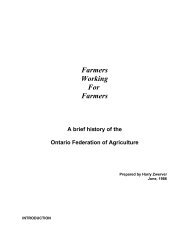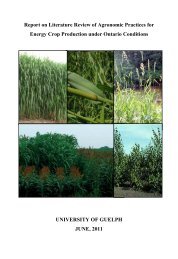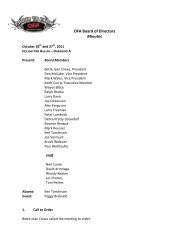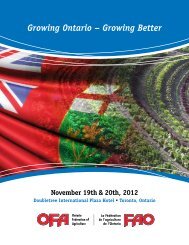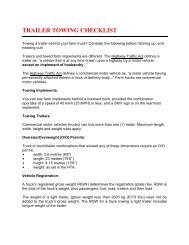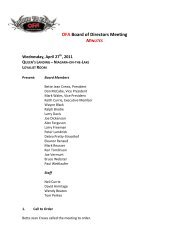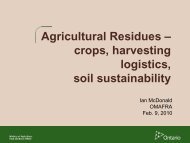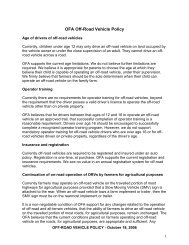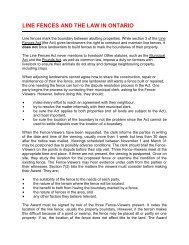Regulatory Compliance Checklist for Employing Farm Workers
Regulatory Compliance Checklist for Employing Farm Workers
Regulatory Compliance Checklist for Employing Farm Workers
You also want an ePaper? Increase the reach of your titles
YUMPU automatically turns print PDFs into web optimized ePapers that Google loves.
MINISTRY OF LABOUR<br />
Duties and Responsibilities under the Occupational Health and Safety Act (OHSA)<br />
What is the OHSA?<br />
OSHA is the key piece of legislation in Ontario governing workplace health and safety. The Act<br />
is based on the Internal Responsibility System (IRS) and is meant to share responsibility<br />
between employers and workers in creating a safe workplace with healthy workers. It sets out a<br />
number of rights and duties <strong>for</strong> employers and workers and establishes a process <strong>for</strong> en<strong>for</strong>cing<br />
the Act where there is non-compliance. For most cases in agriculture, the workplace is<br />
considered to be the farm property, excluding any personal residences.<br />
Getting Started<br />
An important document that new and existing farm employers should have on hand is the<br />
“Guide to the Occupational Health and Safety Act <strong>for</strong> <strong>Farm</strong>ing Operations”.<br />
<strong>Compliance</strong><br />
All farm operations with one or more paid employees are covered under OSHA. It is important to<br />
know that this applies whenever one of your employees is present in the workplace, no matter<br />
how short that time might be.<br />
While there are few substantial requirements <strong>for</strong> farm operations under OSHA, a critical<br />
provision in the Act dictates that employers must “take every precaution reasonable in the<br />
circumstances <strong>for</strong> the protection of a worker”.<br />
To achieve this goal, the legislation requires farm employers to provide workers with:<br />
• In<strong>for</strong>mation on workplace hazards and toxic substances;<br />
• Instruction and supervision <strong>for</strong> farm equipment or hazardous locations;<br />
• An opportunity to identify and resolve health and safety concerns; and<br />
• The right to refuse work that they believe is dangerous without fear of employer reprisal.<br />
Also, it’s important to know that OHSA requires an employer to immediately notify the Ministry of<br />
Labour if a worker is fatally or critically injured in the farm.<br />
Consequences<br />
The Act and its regulations are en<strong>for</strong>ced by Health and Safety Inspectors at the Ministry of<br />
Labour (MOL). Their role is to both inspect workplaces to check <strong>for</strong> compliance with the Act, and<br />
investigate workplace incidents, complaints, and work refusals. MOL inspectors most often visit<br />
workplaces in response to complaints or reports of injuries; however, they will also conduct<br />
random inspections and focused blitzes.<br />
If you are found to be in non-compliance, MOL Inspectors can:<br />
• Write compliance orders that carry specific legal requirements;<br />
• Issue “stop work” orders if there is an immediate risk that a worker could be injured;<br />
• Issue tickets or initiate prosecution where a worker has been injured as a result of noncompliance<br />
The Ontario Federation of Agriculture enables prosperous and sustainable farms.<br />
3



